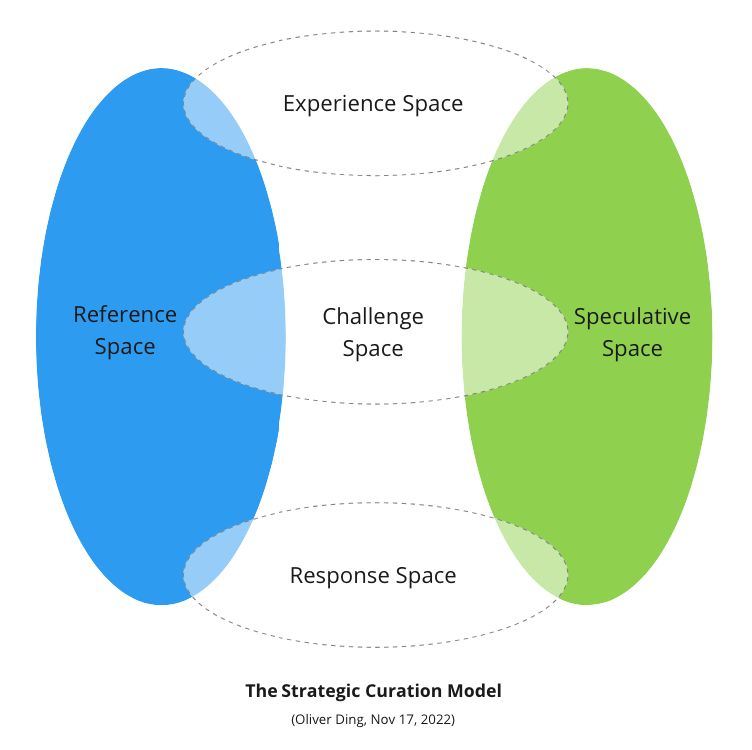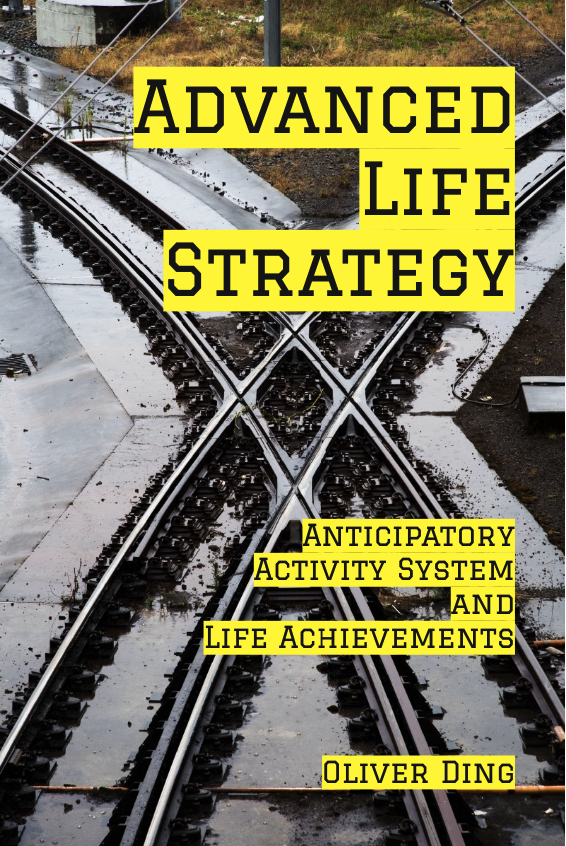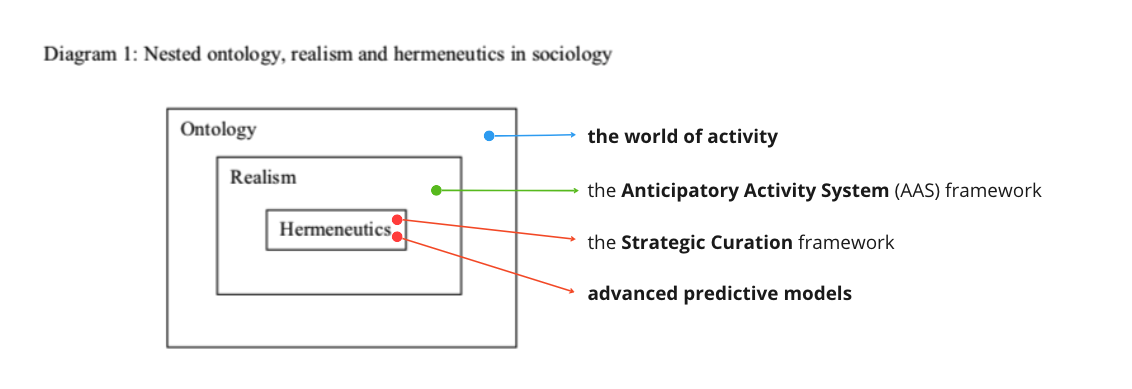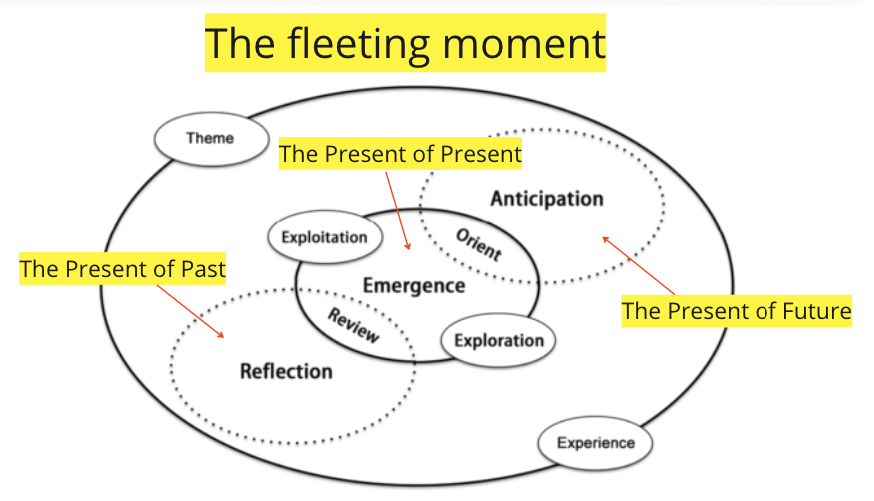A Five-space Model for Strategic Curation Activity

On Nov 17, 2022, I designed a diagram for Strategic Curation Activity

The Strategic Curation Model is a five-space model.
- Experience Space: It refers to the facts of the Past.
- Challenge Space: It refers to the problems in the Present
- Response Space: It refers to the solutions for the Future
- Reference Space: It refers to reliable and validated knowledge for thinking
- Speculative Space: It refers to imaginative thinking such as Counterfactual Thinking about the Past and Prefactual Thinking about the Future.
What does Strategic Curation mean?
It refers to using a specific strategy to curate pieces of experience, knowledge, and resources into a meaningful whole for a better future.
The Strategic Curation model is designed with two types of Thematic Spaces:
- “Thinking” Thematic Space
- “Doing” Thematic Space

- Reference Space: Type=Thinking, Theme=Reference
- Speculative Space: Type=Thinking, Theme=Speculative

- Experience Space: Type=Doing, Theme=Experience
- Challenge Space: Type=Doing, Theme=Challenge
- Response Space: Type=Doing, Theme=Response
The above five thematic spaces form a “Time, Space, Thinking, Doing” structure which offers a map for understanding the complexity of Strategic Cognition.
In the past weeks, I wrote several articles about the Strategic Curation model.
- Life Strategy: A Five-space Model for Strategic Curation (Nov 17, 14 min read)
- Life Strategy: Three Meta-knowledge of Strategic Curation (Dec 5, 8 min read)
- Life Strategy: Turning Potential Knowledge into Actual Knowledge (Dec 7, 9 min read)
- Life Strategy: Conceptual Change and Developmental Resources (Dec 7, 13 min read)
- Life Strategy: Taking Opportunities and Long-term Response (Dec 11, 19 min read)
- Life Strategy: Ecological Strategic Cognition (Dec 8, 8 min read)
1. Why did I develop the Strategic Curation model?
Originally, I developed the Strategic Curation model for the Life Strategy project. I used the following picture to curate a possible book.

The possible book aims to present a systematic approach to life strategy for knowledge creators. It is part of the series of Aspects of Creative Life.
In the past several months, I developed several units of analysis of Creative Life and wrote several possible books.

On Oct 25, 2022, I made a semiotic system for understanding Creative Life. You can find more details in Three Paths of Creative Life and A Semiotic System.

The above semiotic system uses "ontology - realism - hermeneutics" as a reference frame to curate four frameworks.

I use the same structure to curate four ideas for the new possible book: Advanced Life Strategy.

The Anticipatory Activity System (AAS) framework is inspired by Activity Theory, Anticipatory System theory.
According to Robert Rosen, the Anticipatory System theory's creator, “An anticipatory system is a natural system that contains an internal predictive model of itself and of its environment, which allows it to change state at an instant in accord with the model’s predictions pertaining to a later instant.” In contrast, a reactive system only reacts, in the present, to changes that have already occurred in the causal chain, while an anticipatory system’s present behavior involves aspects of the past, present, and future.
The core idea is the “internal predictive model” and the model can predict the Self and the Environment.
What do predictive models look like?
Robert Rosen’s theory is a general theory. Since my framework also considers Activity Theory and other theoretical resources, I have to develop my own ideas of Predictive Models.
I made a distinction between General Predictive Model and Particular Predictive Models for the Life Strategy project.
The General Predictive Model refers to a person’s mind and knowledge.
For a particular project, a person will develop a particular model to help her model the development of the project. In other words, she will use a model to predict the future of the project.
The model can be explicit, such as a diagram with a document. However, the model can be tacit, the person just uses her mind without any instruments to display the model.
What I found from my empirical research is that sometimes the person would like to visualize or write her model about the project because this way is a great way of thinking. But the person would like to keep the model as private information unless the project needs the public version of the model for storytelling.
The model is the outcome of the “objective—subjective” knowledge curation. For example, a friend of mine adopts some psychological knowledge and the OKR method to build a model and use the model to develop her life development program. She modified her model several times in order to match the change of her clients.
The Strategic Curation model was developed to offer a concrete solution for understanding the General Predictive Model and Particular Predictive Models.
2. Strategic Curation Activity
Following the distinction between the General Predictive Model and Particular Predictive Models, we can define two types of Strategic Curation Activity.
- Type 1: It is about curating strategy-related concepts and knowledge. It aims to reflect on the General Predictive Model. In other words, it is about reflecting on our minds, behaviors, and knowledge.
- Type 2: It is about curating situational information around a particular project and developing strategic responses. It aims to create a new Particular Predictive Model and reflect on an old Particular Predictive Model.
The Strategic Curation model is a "map" for visualizing and curating ideas. From the perspective of Activity Theory, it is an instrument for mediation.
I have made several examples of using the model for Strategic Curation Activity. Below are some diagrams. You can find more details in the original articles.
2.1 Predictive Models: Feedforward and Feedback

Original article: Three Meta-knowledge of Strategic Curation
2.2 Near History: Real Experience and Possible Experience

Original article: Three Meta-knowledge of Strategic Curation
2.3 Possible Selves: Like-to-be and Like-to-avoid

Original article: Three Meta-knowledge of Strategic Curation
2.4 Developing Tacit Knowledge: Actual Knowledge and Potential Knowledge

Original article: Turning Potential Knowledge into Actual Knowledge
2.5 Conceptual Change - How did I change my mindset about the concept of “Resouces”?

Original article: Conceptual Change and Developmental Resources
2.6 Taking Opportunities

Original article: Taking Opportunities and Long-term Response
3. Ecological Strategic Cognition
I consider the Strategic Curation model as a new approach to Strategic Cognition which is about strategy-related thinking and doing. The new approach emphasizes the “thinking-doing” connection, spatial cognition, and temporal structure. Since the approach is based on the concept of “Thematic Spaces” which is a core idea of the Ecological Practice approach, I name it Ecological Strategic Cognition.
The term “Strategic Cognition” represents the Cognitive Perspective to theory building and empirical research in strategic management. Its focus is cognitive structures and processes in organizations. Some scholars also pay attention to the Top Management Team (TMT)’s cognitive style and bias.
For the Life Strategy project, I use “Strategic Cognition” to refer to strategy-related thinking and doing. Since the Life Strategy project’s primary unit of analysis is individual life development, I don’t have to consider the complexity of organizational structure. Thus, the term “Strategic Cognition” is very close to Rationality.
Moreover, Strategic Cognition is not only about Rationality and Intelligence, but also Anticipation, Activity, Affection, and Affordance.
The Life Strategy project adopts the Anticipatory Activity System framework to study Advanced Life Strategy. The framework highlights two aspects of Strategic Cognition: Anticipation and Activity. We will use the Strategic Curation model to discuss the other two aspects.

These 4A aspects of Strategic Cognition point to a new approach to Strategy-related thinking and doing. You can find more details in Life Strategy: Ecological Strategic Cognition.
4. Past, Present, and Future
There is a “Past — Present — Future” structure behind the Strategic Curation model.
It was adopted from the following diagram about the Temporal Structure of Creative Life.

My primary interest is located in the intersection between Knowledge, Creativity, and Adult Development. I roughly use Creative Life to name this focus. It’s clear that I don’t want to develop a general framework about adult development for everyone. I only consider Knowledge Workers and Creators as my target audience.
The diagram was based on my diagram about The Path of Creative Life and Ping-keung Lui’s theoretical sociology, especially the notion of the fleeting moment.
In 2007, Lui published a book titled Gaze, Action, and the Social World in which he presented his account of theoretical sociology. The fundamental starting point of his approach is an Ontology of action, which was inspired by Saint Augustine (354–430), Martin Heidegger (1889–1976), and Maurice Merleau-Ponty (1908–1961). See the statement below:
The body is in action, action is in the fleeting moment, the fleeting moment is in the body.
According to Lui, “This moment is Augustinian, it comprises at the same time the Present of the Past, the Present of the Present, and the Present of the Future. The actor Remembers in the present of the past, Pays Attention in the present of the present, Expects in the present of the future.” (p.235–236, 2010, The Scientific Project of Sociology)
There is a connection between the Path of Creative Life and Lui’s ontology of action.
- Reflection: Remembers in the present of the past
- Emergence: Pays Attention in the present of the present
- Anticipation: Expects in the present of the future
The connection encouraged me to adopt Lui’s theoretical sociology as a reference frame for the Creative Life Curation project and the Life Strategy project. You can find more details in Three Paths of Creative Life and A Semiotic System and A Semiotic System Diagram for Creative Life Curation.
